The subtleties of laying mosaic

Nowadays, the mosaic technique is used to decorate houses in order to make them more original. The mosaic can be used both indoors and outdoors. Therefore, it is very important to know the intricacies of mosaic laying.


Peculiarities
Mosaics have adorned buildings for thousands of years. For example, glass was used in mosaics as early as 2500 BC, but glass tiles were not introduced until the third century BC, when Byzantine artists created opaque glass tiles called smalti and used them to decorate walls, ceilings, vault facades. churches and public buildings. Only the very wealthy could afford to use the material for private residences.
This continued until the Victorian era, when glass tiles appeared in mass production, which were much cheaper to manufacture and therefore made available to middle-class homes. In the 1920s Art Deco movement, pigmented structural glass mosaics (best known by Vitrolite) lent a sleek, modern look to walls in shop windows, train stations, and more.


Today, mosaics come in many shapes, sizes, colors and can be used in almost any room in the house. It is most often made from materials that are resistant to high humidity and temperature changes. The high wear resistance allows the mosaic decor to be used in various places. Mosaic tiles are similar to cladding: they are highly durable. The aesthetic appearance of the product is preserved for a long time.
Mosaic tiles can be cut into pieces to the desired length and width, making it easier to install in hard to reach places. A large assortment of mosaics allows you to create any decorative panel, an interesting pattern.



Views
There are three main types of mosaics: glass, ceramic, stone. Each type has its own characteristics and production technology, so it is important to familiarize yourself with them in more detail.
- Glass mosaic. It adds extravagant color and shine to the interior, but will only be visible on the backing. The mosaic is also made of frosted glass. This mosaic is a flatter, more opaque alternative to clear glass. Bubble glass is also popular in mosaic making. This option consists of small air bubbles in the glass, which adds visual interest to the interior. Glass mosaic can also look like no crystal. It is made of glass that resembles precious stones - best used as an accent on certain parts of a wall or floor.


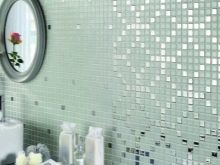
- Ceramic mosaic. It is made of glass powder, pressed into dies and heated until the particles coalesce. This expensive material is suitable for finishing any area of the house. The mosaic is covered with a glossy glaze or remains matt. Laying ceramic mosaics allows you to get a relief non-slip surface. Ceramics are resistant to mechanical damage and abrasive detergents.


- Stone mosaic. This is a multi-layered, multi-colored mosaic made from pieces of quartz, marble chips, granite, slate or travertine. This material is very durable, so it is used not only for wall decoration, but also for flooring.The stone mosaic has a natural aesthetic, giving the room a special style. There is also a stone mosaic made under a tree. Wooden tiles are perfect for decorating outdoor structures.


Which one to choose?
The choice of the mosaic depends on its location.
- The most popular home use of mosaics is in bathrooms and kitchens. But the material is not limited to just a shower or an apron in the kitchen.
- The sides and bottoms of ladder pools can include stunning, thoughtful glass mosaic designs. This adds a sparkle to the light, it reflects the light and makes the water look beautiful when viewed from a low altitude. This is the main reason for using glass mosaics in showers, kitchens, pools and spa.
- It is ideal for watersheds such as fountains, where glass tiles can appear delicate, almost ethereal.
- Glass mosaics can also decorate outdoor benches and freestanding art installations.

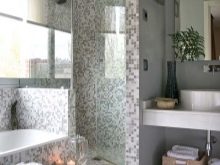

To decorate surfaces, you can use mosaic in combination with ceramics and metal, because it gives a matte, opaque surface.
There are even mosaic wallpaper: small tiles assembled into modules that make it easier to repeat patterns on the walls. These tiles can be applied to both flat and curved surfaces, so they are used instead of wallpaper.
There are mosaic rugs: tiny, perfectly shaped handcrafted glass tiles attached to a flexible surface that create classic carpet patterns such as vines and leaves. The surface durability means that the rugs can be placed in porches and other high traffic areas, or they can also be hung on the wall like tapestries.



Preparation
Many experts recommend using experienced professionals to install the mosaic, but you can do it yourself. First you need to make a "dry" layout of the mosaic and mark each piece. This is necessary to accurately locate elements and ensure color matching.
Having laid out the proposed pattern on the surface, it is worth checking that the pieces of the tile are fixed with adhesive tape and numbered - this will facilitate further assembly of the ornament.
After the layout, a sketch is created.


When developing a mosaic tile pattern, some nuances must be taken into account.
- It is advisable to position the pattern from the most illuminated area or from the center of the image. The pieces of the mosaic should be placed at the edges or in the inner corners, in inconspicuous parts.
- If there are outer corners, the image layout starts there. The priority element for getting started is any decorative element of the room: panel, mirror, niche.
- After laying, numbering and creating a detailed sketch, the mosaic sheets should be carefully folded back into the boxes. On the wall or on the floor, it is necessary to mark the boundaries of the mosaic pattern; a laser ruler is useful for this purpose.


You need to prepare the following tools:
- moisture resistant antifungal primer;
- adhesive composition;
- grouting device;
- rubberized spatula for leveling and pressing plates;
- notched trowel;
- surface pouring roller;
- construction mixer for uniform mixing of glue;
- tray for the preparation of glue.

The glue should be mixed in accordance with the following rules, this is the only way the mosaic tiles will last for a long time:
- water is poured into the container on a tray and the dry mixture is added;
- the solution is mixed twice with an interval of 60 seconds;
- the duration of the first mixing should be 5 minutes.

How to do it yourself?
Mosaic installation is a simple, but painstaking task, which is usually done by craftsmen, but you can try and lay small tiles yourself.
The sequence of laying mosaic tiles is as follows:
- notched trowels should be placed on the prepared surface for applying the adhesive solution. In due time, it is necessary to cover an area that can be polished within half an hour;
- it is worth applying the mosaic sheet and pressing lightly. To distribute the adhesive evenly, the surface can be rolled with a roller. It is important to make sure that the distance between the squares remains the same and that the adhesive does not penetrate the front of the mosaic. To keep the gaps between elements at the same level, you need to use crosses;
- you need to carefully remove the film and leave the glue to dry for one or two days. Excess adhesive solution should be removed half an hour after fixing the mosaic, because it will be difficult to do this later.


Tile loads are allowed only after final drying and fixing of the mosaic. The order of grouting is as follows:
- you need to prepare the spatula following the instructions on the package;
- for the convenience of cleaning the tiles from traces of grouting, the surface must first be treated with protective sprays. After 20-30 minutes, you can start rubbing the seams.
- the mortar should be applied to the spatula and the seams should be filled in with wide movements, moving diagonally. The spatula should be slightly pressed so that the mortar is slightly below the level of the mosaic;
- the solution should be slightly moistened so that it does not get wet in water and does not crack. You can use a damp sponge or a small spray on the flowers;
- after 20 minutes, when the solution hardens slightly, the excess mixture should be removed by passing the coating with a damp hard sponge. Remains of baked cement dust can be removed with a 5% sulfuric acid solution;
- rinse the mosaic with clean water immediately after sanding.


Important! If the tile is used to create a kitchen backsplash, then it is necessary to mark the lower edge of the backsplash on the level. It is he who will be decisive in the even arrangement of the mosaic. It is necessary to fasten the profile with dimensions of 27x28 cm to the wall. The profile acts as a support. Thanks to its presence, the tiles will not slip.

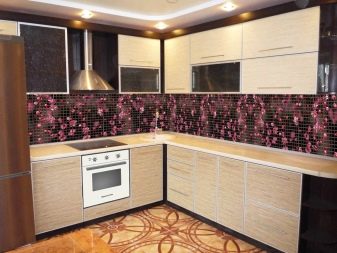
For information on how to properly lay the mosaic, see the next video.
Tips & Tricks
Mosaic options offer a unique look and unmatched gloss over other floor, wall and countertop materials. Transparent tiles can add an unusual depth effect to a surface that other materials cannot achieve. Mosaic tiles are also resistant to stains, mildew and allergens. They are easy to wipe off and do not stain.
You need to understand that the glossy surface of the mosaic will leave fingerprints. Traces appear more clearly on such surfaces than on dull surfaces, so frequent cleaning may be required to maintain a smooth shine. There are some mosaic variations that will scratch over time.
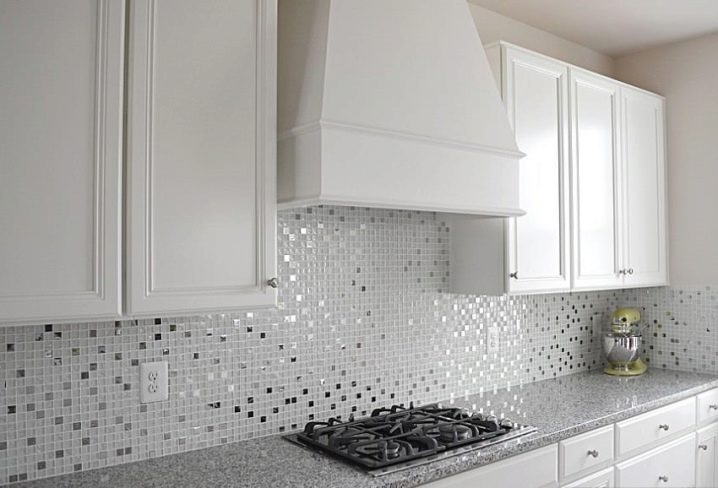
Also, when considering tiles for a bathroom or shower floor, keep in mind that mosaics can be slippery and feel colder underfoot., unlike conventional porcelain or ceramic tiles. Of course, using a mosaic on the shower floor makes it easier to create a slope, and the special grout between the smaller pieces gives it some grip. But depending on how smooth and polished the surface is, it can be slippery.
Applying a special sealant after installation is one solution to this problem. It is recommended to use glass wall tiles and limit their use on floors to accents and designer borders.


Mosaics can be made from 100% post-consumer recycled glass or from "post-industrial" glass: that is, they are broken pieces as a result of the production of other glass products. Using recycled material eliminates the energy cost of producing entirely new materials.In addition, re-molding glass typically uses less energy than creating glass slabs from scratch. Therefore, the mosaic is well tolerated by people with chemical sensitivity.
For the best ecological result, it is worth buying a 100% recycled mosaic. You can look for a local supplier who sells broken tiles.


The mosaic coating in the bathroom should be periodically treated with special fungicidal agents. This must be done if the ventilation is not doing its job. For cleaning, it is advisable to choose gel-like detergents without abrasive components. Contaminated areas of the panel can be wiped with a soft sponge dipped in soapy water. Finally, rinse with water and wipe dry.
The surface of the mosaic cannot be wiped with oily substances, phosphoric acid and wax.


With the help of mosaics, you can give a second life to old things. Square or rectangular tables are the easiest to decorate with mosaic tiles. Although mosaics or other small tiles can be used on a round surface with a smooth surface.
If you are planning a custom design, you first need to lay out the tiles so that you know exactly how it will look. For a table to be used outside, more glue should be applied to the center so that it is slightly higher than the sides.
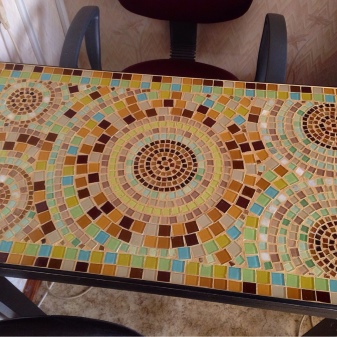

Applying tiles around the edges of the mirror will create an attractive and unique frame. If it's a bathroom mirror, you can use the same color scheme as the tiles in the shower. There are several ways to decorate a mirror. You need to apply tiles directly to the surface, draw a border around the mirror and hang the mirror. To glue the tiles directly into the mirror, use a 100% silicone sealant. But you can see the reverse side of the tiles reflected in the mirror, so it is better to use a transparent sealant and tiles with a dark side.
If the tiles will be positioned around a mirror, apply the grout directly to the tiles and attach them to the wall. Thus, there will be no excess glue on the walls, which will be difficult to clean later.

Beautiful examples
Mosaic tiles are one of the most popular and widely used tiles on the market. It is used to give a beautiful and original look to houses.
Living room
To create solid interiors for your home, you can cover half or entire walls with these slabs. Finding a mosaic that suits your taste will be an easy task. If you are looking for full wall tiles, mosaic tiles are great for creating accents in a room. It is worth installing mosaic inserts in squares along the painted wall or inserting them into the work surface in the kitchen.
Mosaic tiles can also be used to create decorative detailing within a frame on any wall, or to frame a mirror or window. Whichever style you choose, you can try creating a mosaic tile border around the edge of the floor. When choosing a boundary, you should carefully consider the shape of the space and make sure that the area breaks up without looking at it.

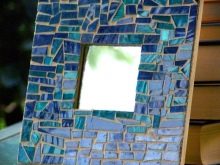

Flooring
Mosaics can really help create beautiful floors. Whether it's your bathroom, living room or backyard flooring, the right tiles can be used to create attractive floors and walkways.
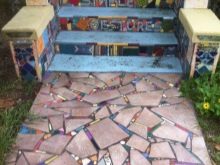


Bathroom
It is possible to use mosaic tiles in the shower area to give it a luxurious look and charming appeal. When the place looks beautiful, the shower automatically becomes more pleasant. In the bathroom, for example, mosaic tiles can be used to create attractive wall decor. More complex images and designs can also be created in the bathroom. Of course, if you want to create a cohesive interior design, you can cover the entire wall with mosaics.



Splash splashes are practical elements in a room where there is a lot of water or steam, such as a bathroom or kitchen. Their main function is to prevent water damage to the wall, but this does not mean that they cannot be beautiful. It is recommended to use mosaic tiles in one color block to contrast or complement the color scheme in the rest of the room.
It is also worth choosing a bold pattern to create a decorative dot of interest. Mosaic tile pieces don't have to be just rectangular; you need to get creative and create a curved or reverse splash that draws attention to other features in the room.


Kitchen
The kitchen is considered the heart of the home. You can use mosaic tiles on the countertop or create a backsplash design. These tiles will surely add new charm to your kitchen. In the kitchen, mosaics are the focal point of all decor. This is why mosaic tiles are a great option. You can use them to create something complex.
Another option is to use mosaic tiles as purely decorative elements and create interesting designs, the mosaic can also be cut to give it an interesting look. The mosaic around the windows can also be used to decorate key areas of the kitchen. If the kitchen is large enough to accommodate an island, then there is the option to include mosaic tiles in your design as well. In this case, you can not be afraid of mosaic chips.



Outdoor structures
To make your patio more interesting and visually appealing, you can surround yourself with vibrant colors and patterns. It is worth putting the mosaic on the floor. The use of pebbles or tiles is recommended. For a beach-style design, try a different mosaic. Use large stones or paving stones and allow the grass to grow through them. You need to arrange them in a spiral shape around the fireplace to simulate a sink. This option is suitable for warm weather conditions.


A mosaic path made of broken tiles perfectly complements a modern home. The comparison of materials and the interaction of wood and stone are also interesting. You can stack them one at a time. The thickness of the mosaic may vary. While this is quite unusual, you can also use a mosaic on your fence to make it more interesting.
You can lay out the mosaic only on concrete fences with a smooth surface.


The modern patio has a very relaxed and casual design and a chic view. The seats are definitely quirky, with white mosaics with gold accents on the mesh... This is a great mosaic tile idea for a frequent home. Plants will always make a home beautiful, but if the decision is made to create planters from mosaics, the beauty of the home is quadrupled.

If you are looking to renovate your home or build a new one, you should consider using mosaic tiles to add beauty and grace to your home. This will help create a decor that suits the wishes of the owner.













The comment was sent successfully.